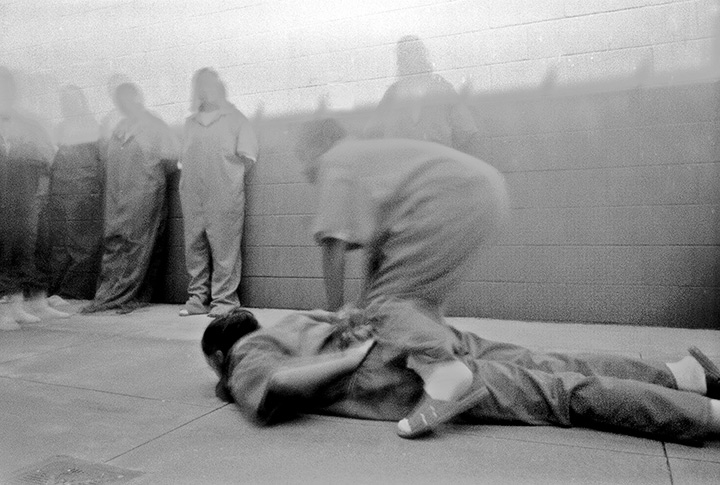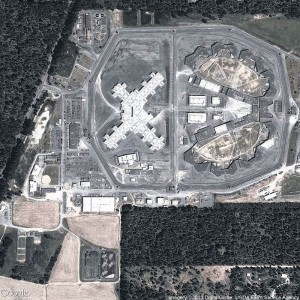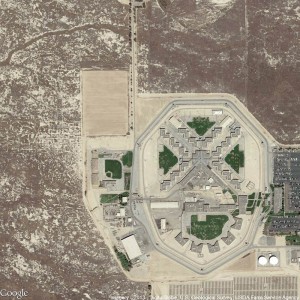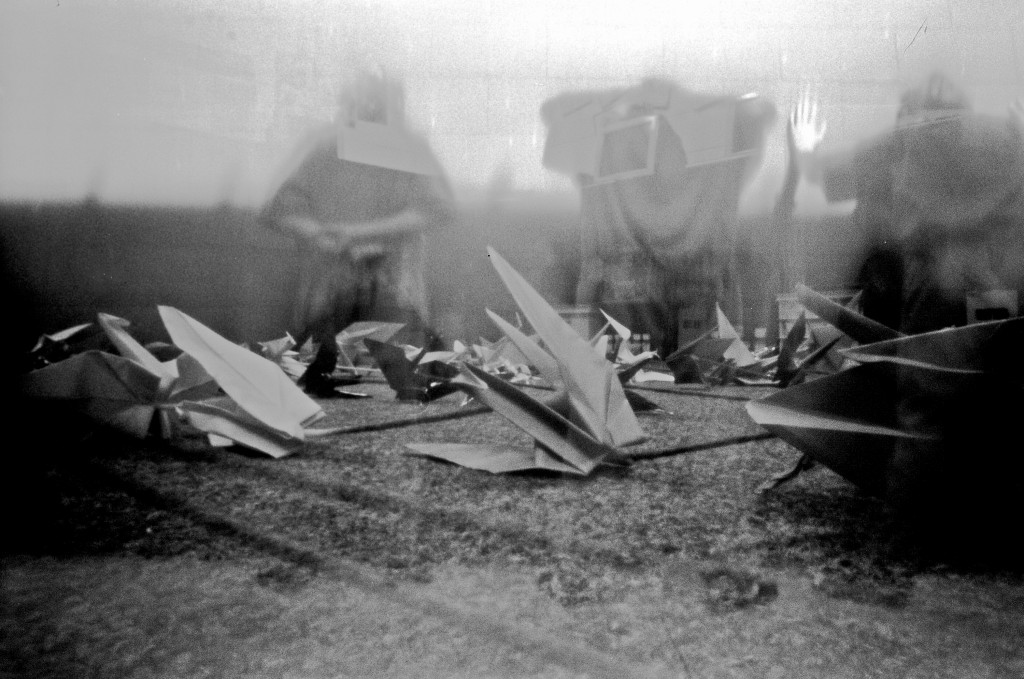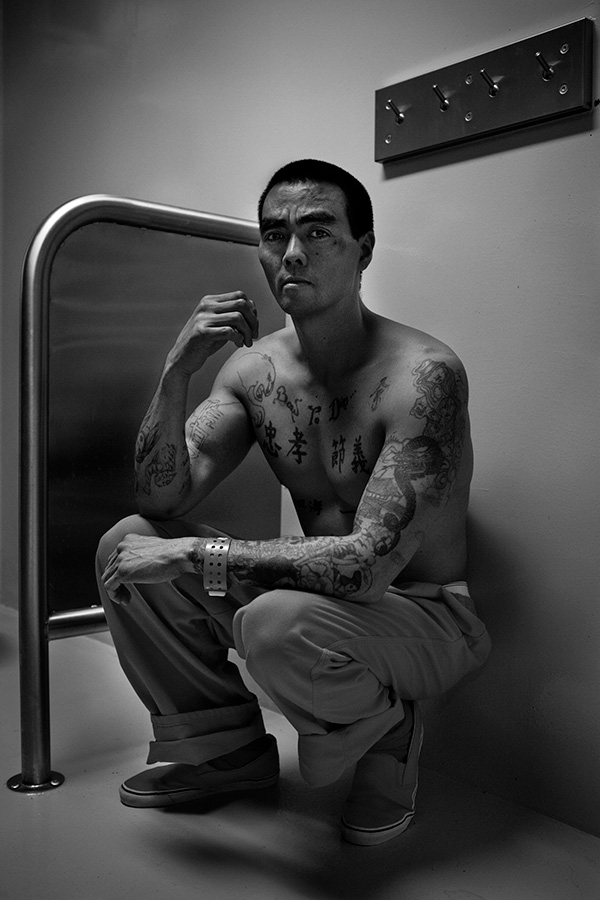PRISON OBSCURA
How does photography serve to legitimate and normalize existing power relationships? How is historical and social memory preserved, transformed, restricted and obliterated by photographs?
—Allan Sekula
A pinhole punctures one side of the box-shaped camera obscura or “dark chamber,” allowing a small ray of light to slip into the darkened interior. Projecting an upside-down, left-to-right reversed image of the outside world on the opposite wall, the box might allegorize sight itself, shadowing the play of inverted light shared between pupil and retina. “The image in the camera obscura looks so real and yet there is clearly something fundamentally wrong with it,” writes critic Gen Doy. “Using a mirror can make things look right, but that merely changes things on the level of sight, not comprehension. For that you need to stand outside of the darkened box.” 1
Prison Obscura considers this fundamental distortion that characterizes vision and viewing, how we see and don’t see the people we incarcerate, the people we put in boxes. Guiding the viewer through the visual culture of America’s prisons, the exhibit traces the contours of that box, to attempt to make sense of the dominant narratives and stereotypes that somehow justify a U.S. system now locking up people at an unprecedented rate. What do we know of our prisons? Do photographs help us know? Are the images of prisons we see reliable? Are they even useful? How do images relate to the political, social, and economic realities that exist within our prison industrial complex? Do prisons, as closed sites, present any challenges to the claims photography makes as a medium of communication?
The works in Prison Obscura direct audiences toward creativity and activism, calling for a responsible consumption of images. While the artists in the exhibit co-create and capture experiences, their works press on a more conventional documentary tradition so powerfully shaped by the efforts of Lewis Hine and Jacob Riis. In their wake great documentarians such as Danny Lyon, Bruce Jackson, and Ethan Hoffman plugged images of prisons into the discourses of race and class inequality during the sixties and seventies. In the past few decades, however, such documentary photography has come under scrutiny for commodifying tragedy and hardship; for parachuting into grave situations and leaving just as quickly; and for being the reserve of Western photographers and white, male patriarchy. The debate is of course more nuanced, but the foundational criticism is that a constant flow of silver gelatin prints serves to codify catastrophe as happening elsewhere, anesthetizing the viewer to the individuality of human suffering.
Allan Sekula’s refusal to think of photography as a benign or neutral medium is pertinent to this discourse on human pain and prison images, especially when representations of and from prisons are tightly controlled and legislated by the interests of the dominant power, namely the prison authority. What images of prisons are routinely or automatically manufactured? What scenes in prisons are never documented? What images are suppressed, or worse still, destroyed? Prison Obscura exists within a context of innumerable nascent, unseen images of U.S. prisons.
Mass incarceration is a manmade problem. So feasibly, it can be unmade. The issues are many: egregious sentencing, gutted rehabilitation and education programs, substandard physical and mental health care, aging prisoners, the expanded use of prisons for youth, amplified hardships for women and families, and persistent violence. The deep roots of these difficult conditions are complex, even overwhelming. The work of Prison Obscura is to give image and voice both to the causes of, and the individuals marked by, these issues.
Josh Begley and Paul Rucker: Data and the Visualization of Mass Incarceration
One in 100 American adults lives behind bars. Whether we accept it—whether we see it—we live in a prison nation, and the prisons are ours. One of the most difficult tasks in depicting the prison industrial complex is imaging (and imagining) its sheer size. In the course of a single year, 13.5 million Americans are incarcerated. On any given day 2.2 million men, women, and children are behind bars. These two figures reflect the constant cycling of bodies through the gates and cells of over 5,000 locked facilities.
American taxpayers spend $70 billion per year on corrections and incarceration.
The American prison system has not always been this massive. Until the 1980s, the prison population was a quarter of its current size, but it has since exploded thanks to the “War on Drugs” rhetoric introduced by Richard Nixon and the subsequent federal policies enacted by Ronald Reagan, many of which concomitantly dispensed with safety nets for society’s most vulnerable. In the nineties, a raft of high profile crimes fuelled public fear, and politicians from both sides of the aisle responded with inflated promises to keep the public safe: Virtually every state passed voter-endorsed Three Strikes Laws that introduced longer mandatory-minimum sentences. The need for prison cells rocketed. In California, for example, it was not unusual for some prisons to house twice the capacity for which they were designed. Some still do.
With the use of satellite imagery and animated video, respectively, artist Josh Begley and musician-composer Paul Rucker address the size and scope of America’s prison system. Coincidently, they both use data provided by the same reform group, the Prison Policy Initiative.
Rucker’s animated video Proliferation compresses 250 years of prison construction into 10 minutes. From a black screen, different colored dots appear: each dot represents a single prison or jail; each color, a specific stretch of years—green: 1778-1900; yellow: 1901-1940; orange: 1941-1980; and red: 1981-2005. The speed and density of the dots accelerates as the video progresses, the result resembling a cellphone coverage map. The swath of red that remains at the end is a sharp visual jolt, a forthright reminder that our current reliance on prisons is a historical anomaly.
Who are these people we’ve locked up? Many are not the hardened criminals popular media might have us believe. Some are low-level drug-dealers; many are addicts; a disturbing number have diagnosed mental health issues. At the same time the prison boom began in the 1980s, mental health institutions were shuttered and never adequately replaced with social services or community supervision. Consequently, a good proportion of prisoners are corner-dealers, people with addiction, people with mental health needs, and people without homes. Crucially, many prisoners on long sentences have never committed a violent crime.
Bryan Stevenson, founder and executive director of the Equal Justice Initiative, believes that with the political and cultural will we could release nearly a million people tomorrow, and in so doing replace imprisonment with education, rehabilitation, and treatment:
We have close to a million people in prison for non-violent property crimes or drug crimes. Frankly, if someone stole $50 from your house, you’re never going to get that back in our current system, but you can imagine a world where the obligation to pay back to restore and to compensate the victims of crime in ways that are meaningful could replace the use of prisons to punish and crush folks. 2
Without any threat to public safety, society could scale back its reliance on incarceration and still tackle—more humanely and inexpensively—the root causes of this population’s transgressions.
When prisoners have not been maligned in mainstream media, they have been strategically isolated to the point of invisibility. The majority of recent prison construction has been tied to boosterism in depressed, post-industrial rural America. As a consequence, prisons are located in small towns, high deserts, and remote corners of states. For families of prisoners, visitation is prohibitively expensive and time-consuming. For the general public, the architecture of incarceration is hidden.
Josh Begley’s Prison Map makes visible these distant concrete citadels. Prison Map, which Begley has recoded exclusively for Prison Obscura, is disarmingly simple in its design but powerfully comprehensive in its panoptic coverage. Begley manipulates the Google Maps API to write code that uses longitudinal and latitudinal coordinates in creating aerial satellite views of every carceral facility in the U.S. The resultant 5,000 images tell us much about prison architectures and siting. We see common patterns in prison design, namely the spider-like organization of pods and units of maximum and super-maximum facilities like Pelican Bay State Prison.
California built this first state-operated Supermax in 1989, and it has provided the model for 60 similar facilities across the nation. Supermaxes are designed for long-term isolation and sensory deprivation. Conservative estimates put the number of Americans in solitary on any given day at 20,000. Many reform groups say the figure may be as high as 75,000 depending on the parameters of one’s definition. The widespread use of solitary confinement is American exceptionalism at its worst. In June 2011, Juan E. Méndez, UN Special Rapporteur on Torture, reported to the UN General Assembly that solitary permanently damages the mental health of prisoners and should not be used for a period of more than 15 days.
Physician Atul Gawande has compared the permanent psychological impairment of solitary to that incurred by traumatic brain injury. 3 Dr. Stuart Grassian, forensic psychiatrist and former faculty member at Harvard Medical School, interviewed more than two hundred prisoners in solitary confinement, concluding that about a third developed acute psychosis with hallucinations. 4 Neither Mendez’s recommendations to the UN nor the conclusions of these scientific studies are new information for our legislators. In June 2006, the Commission on Safety and Abuse in America’s Prisons, a bipartisan national task force, reported that, “beyond about ten days [of solitary confinement] practically no benefits can be found and the harm is clear—not just for inmates but for the public as well.” And yet, U.S. states remain invested in the practice, frequently using solitary to punish minor infractions: It is no longer reserved for “the worst of the worst” as corrections departments often insist.
Begley’s Prison Map discloses the terrifying size and brutality of both isolation and expanse in our prison system. And yet the map component is merely an overview. By using the publicly available embedded data on town, state, and security level, users can drill down and investigate for themselves. Granted, Begley possesses the software skills to manipulate the data, but in an age of open source collaboration, Prison Map may be the opening gambit in a public enterprise that uses any single satellite image as a visual turnkey to the statistics, history, and news items on a specific prison.
Kristen S. Wilkins: Women’s Struggle
The effect of mass incarceration on women has been particularly acute. Between 1977 and 2004, the number of women imprisoned has leapt 757%, from 11,000 to 111,000. 5 Today the figure has been estimated at close to 200,000. 6 The majority of these convictions are a result of the War On Drugs, which introduced new mandatory minimum sentencing laws for existing drug crimes and annulled judges’ discretion, allowing them only the option to sentence convicted persons to firm, longer custodial sentences.
An expensive failure 7, the War On Drugs also ushered in new legal definitions of behavior to codify crimes. “Conspiracy” is now a catch-all charge used by Federal investigators working narcotics cases: By virtue of proximity to the site of sale or by personal relationship to the seller, a person can face conspiracy charges even when it cannot be proven he or she bought or sold drugs. Women, often women in poor neighborhoods, are the frequent victims of broad-brush conspiracy charges. Many of these women are further subjected to misogyny and prejudice in a society that accepts vicious characterizations of female prisoners as “fallen” or morally derelict.
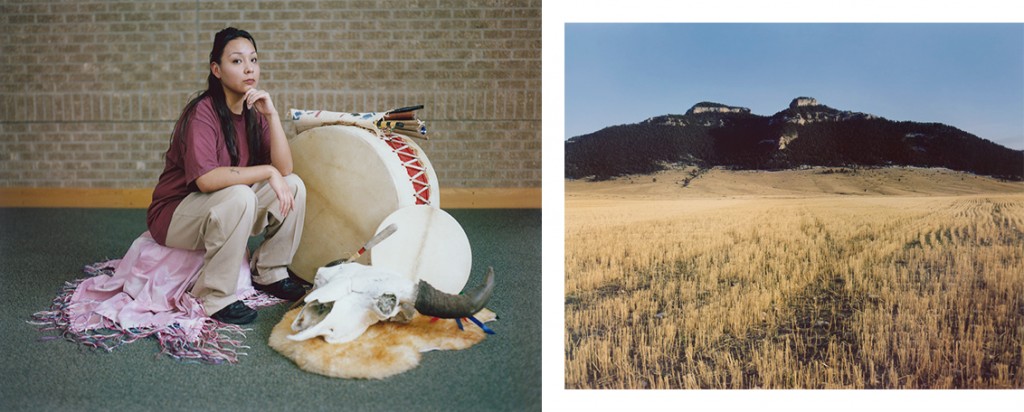
Kristen Wilkins, Supplication #4
“The Pryor Mountains. It is so special to me because I
am from Pryor and I miss home. Castlerock at sunset.”
Kristen S. Wilkins’ project Supplication creates dignified portraits of incarcerated women, rare respectful treatments of a group that has been roundly battered by the lengthening of sentences across the criminal justice system. The state of Montana, where Kristen worked with the women, is particularly punitive. While the number of women imprisoned nationally has shot up 800 percent, the number in the Mountain State’s prisons has leapt 1,600 percent. 8 Mugshots of these women are often found in Montana’s local papers, and Supplication is Wilkins’ response to their ubiquitous presence.
“Mugshots,” writes Wilkins, “are meant to document a transgressor, but act to criminalize individuals and strip them of identity and sympathy.” Pushing back against the visual exploitation, Wilkins aims both to restore some level of empowerment for her subjects and to balance the equation between the convicted person and the camera lens. Wilkins and the women speak at length about historical portraiture, self-representation, power, and control. Beyond the informed choices that Wilkins offers her subjects, she wants to build on the individual creativity of each woman.
The women possessed photographs of husbands, children, family, and friends when Wilkins met them; thus, she offers to photograph the sights they were surprised to miss—sunrises, sunsets, past homes, mountains, kittens, graves, and stores. These seemingly mundane scenes, given to the women as printed photos and reproduced here as diptychs, reflect lives and imaginations that stretch beyond the prison cell.
Alyse Emdur: Prison Portraits as Escapism and Family Treasures
It was the incongruous colors that first drew in artist Alyse Emdur. Finding a Polaroid of her 5-year-old self with her incarcerated brother, she noticed behind them a tropical beach scene. Prisons have a rich but scarcely studied history of mural painting, and in recent decades murals in prison visiting rooms have been used more frequently as backdrops for portraits. An appointed prisoner most often paints the murals. Usually, the visiting room photographer is a prisoner. At one time Polaroid cameras were the norm for this practice, but digital cameras have since replaced them, and printed vinyl backdrops have succeeded the painted murals.
Regardless of the technological changes, such spaces still aim to create corners in visiting rooms that appear “non-institutional.” “They really are like portrait studios,” says Emdur. “In some places there are even lights set up in the ceiling special for the picture. Some portrait studios have ceiling mounted carousels with rotating backdrops which have ten backdrops.”9
Given the enormity of the American prison population, tens of millions of these informal portraits—made both for families and for prisoners themselves—must exist. Is it surprising that this long-practiced mode of American vernacular photography has only recently surfaced in the public sphere? 10 Yes, but the long-overdue emergence of the “genre” is consistent with a general culture that has habitually ignored the emotional territories journeyed by prisoners’ families. “These images offer an opportunity to see America’s prison population, not through the usual lens of criminality, but through the eyes of inmates’ loved ones,” says Emdur.
When viewing Prison Landscapes, we might wonder who these families are. Predominantly, they are families of poor minorities. If current incarceration trends continue, one in every three black men born today will go to prison at some point in their lives, compared with one in every six Latino males, and one in every 17 white males. 11 Black women are four times more likely to be incarcerated than white women. 12 Over half the female prison population is comprised of women of color, and yet women of color account for only about a quarter of the female population generally. 13 Of the 1.5 million children with incarcerated parents, half are African-American children. That’s one in fourteen black children in the U.S. 14
In a culture that portrays men of color as threatening, the visiting room portraits offer a hint of humanizing self-representation. Ironically, these fantasy-landscape portraits also function as instruments of power for prisons. The backdrops ensure that photos of doors, windows, or locks will not circulate outside the prison. “The images are intentionally framed to block out everything outside the frame,” says Emdur, “so the images are hiding what the visiting room actually looks like.”
Emdur’s large-format photographs of visiting rooms in eight different prisons contextualize the frames around the backdrops. By drawing back, she shows us the stages and performances used by America’s prisoners to provide keepsakes for their loved ones. In an age when most people can make, share, and trash digital images in seconds with mobile devices, these single, precious prints remind us that self-representation is not a guaranteed right.
Steve Davis: Giving Kids a Camera, Giving Kids a Platform
With an average cost of $80,000 per year to lock up a child, the U.S. spends more than $5 billion annually on youth detention. America locks up children at more than six times the rate of any other developed nation. On any given night, there are approximately 60,500 youth confined in juvenile correctional facilities or other residential programs. 15 These children often suffer from conditions of psychological, physical and sexual abuse, homelessness, suicide attempts, addiction, and illiteracy.
Repeated studies have shown that youth incarceration does not reduce recidivism rates or benefit public safety, and many states have turned away from punishing acts such as truancy and delinquency with detention. Furthermore, states that most radically lowered juvenile confinement rates from 1997 to 2007 saw the greatest declines in juvenile violent crime arrests. 16 Along with these reductions in detention rates, some facilities continue to experiment with arts programs as models for creative responses to devastating social conditions.
Artist Steve Davis conducted photography workshops in four Washington State juvenile detention halls. Prison Obscura features work by children at the Maple Lane and Green Hill schools for boys and Remann Hall School for girls. Not only do the arts give these children a creative outlet and opportunity for storytelling, they provide broader audiences with a window into these children’s lives and circumstance.
The girls, who could not be identified by face for legal reasons, were given pinhole cameras with long exposures to create blurred photographs, resulting in a series of eerie and morose images. Because the boys had access to the cameras outside of structured class time, their images capture a freedom of invention that would have been difficult to document more formally. At times, their photos show discomforting—if understandable—images of machismo posturing, but they are also clear evidence that these boys are exactly that: boys, not men.
Robert Gumpert: Tackling Invisibility and Voicelessness
Ask Robert Gumpert what Take A Picture, Tell A Story is and he’ll dodge any label. This nine-year project in the jails of San Francisco is neither activism nor journalism, he says. It is storytelling and it is prisoners themselves who are telling the stories. Gumpert’s portraits sit stylistically within the documentary tradition—high contrast, black and white, scars and gripping gazes. Audio recordings of prisoners’ stories, however, are the heart of the works, and they prove how much is missing from any isolated documentary photograph.
The agreement Gumpert proposes with his subjects is simple: He’ll make a portrait of a prisoner and give them four prints in exchange for a story. He does not set the topic, instead he gives prisoners the opportunity to recount their uninterrupted thoughts. The methodology seems straightforward, and yet one rarely comes across this combination of image and audio in such a context. We may hear sound-bites of a prisoner’s voice in a radio program or online multimedia presentation, but it usually lacks the raw quality of the scores of recordings that Gumpert has uploaded to his website.
That the audio is uncensored is vital. While Prison Obscura is curated from a point of political opposition to prisons, it is not intended to whitewash the seriousness of crime or to deny the incorrigibility of some people in prison. Take A Picture, Tell A Story delivers uncomfortable content, stories that remind us that one can oppose the injustices of our prison system without embracing violence and criminality.
Mark Strandquist: Discussing Photography, Forging Connections Across Boundaries
Cameras provide security for prison administrations. In the hands of others, however, they are a security hazard. Accordingly, photography workshops such as those coordinated by Steve Davis have not been practiced in American adult facilities, save for a very brief period. In the 1970s, the Floating Foundation of Photography (FFP) delivered photo-education in eight New York state prisons. Guest teachers at FFP included famous photographers such as W. Eugene Smith, Arthur Tress, Mary Ellen Mark, and Lisette Model. In the 1980s, Karen Ruckman coordinated a photography skills class in Lorton Prison, Lauren Hill, Virginia. With the exception of these two multi-year programs, however, photography has never gained a foothold in the arts programs of American prisons.
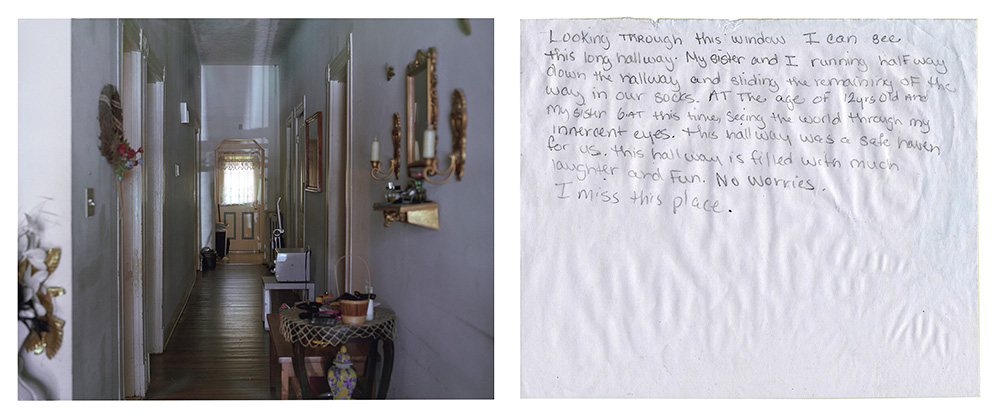
Mark Strandquist, 1219 Oakwood Ave, A Picture of the Hallway Standing From the Entrance of the Front Door in Direction of the Back Door. Two Years.
From the series Some Other Places We’ve Missed.
Mark Strandquist’s Some Other Places We’ve Missed takes us back to that earlier era of pedagogical experimentation and optimism, sharing with us the voices, regrets, and dreams of just a small number of men incarcerated in Virginia and Washington D.C. jails. Strandquist operated a photography workshop with no cameras! His simple question, “If you had a window in your cell, what place from your past would it look out to?” acts as proxy to any release of the shutter, instead asking students to think photographically. While Strandquist then makes the images beyond the prison walls, the essential contributions of his subjects—their memories and self-reflections—shape the project.
Are the photographs enough? On their own, probably not. The 1/125th of a second needed to make a photograph is a perverse fraction of the months and years many spend imprisoned. Strandquist invites gallery-goers to receive and, if they feel compelled, to fulfill photo requests from prisoners, thus transforming the project into a widespread effort by diverse collaborators.
Litigation Photographs: Anonymous Yet Transformational
When Justice Kennedy included three photographs of California prisons in the appendix of the majority ruling of Brown v. Plata (May 2011), there was widespread consternation. Protestors proclaimed the photographs of holding cages and overcrowded living quarters too imprecise and emotional to have any place in a high profile legal case.
Brown v. Plata was a class action lawsuit brought by prisoners against the State of California. Ultimately, the US Supreme Court ruled that prison overcrowding had resulted in inadequate healthcare and preventable deaths. As a result, every one of California’s 160,000 prisoners was recognized as suffering cruel and unusual detention in violation of 8th Amendment rights. Prior to Brown v. Plata, the Golden State warehoused the largest prison population of any state, an ignominious distinction California held for 25 years.
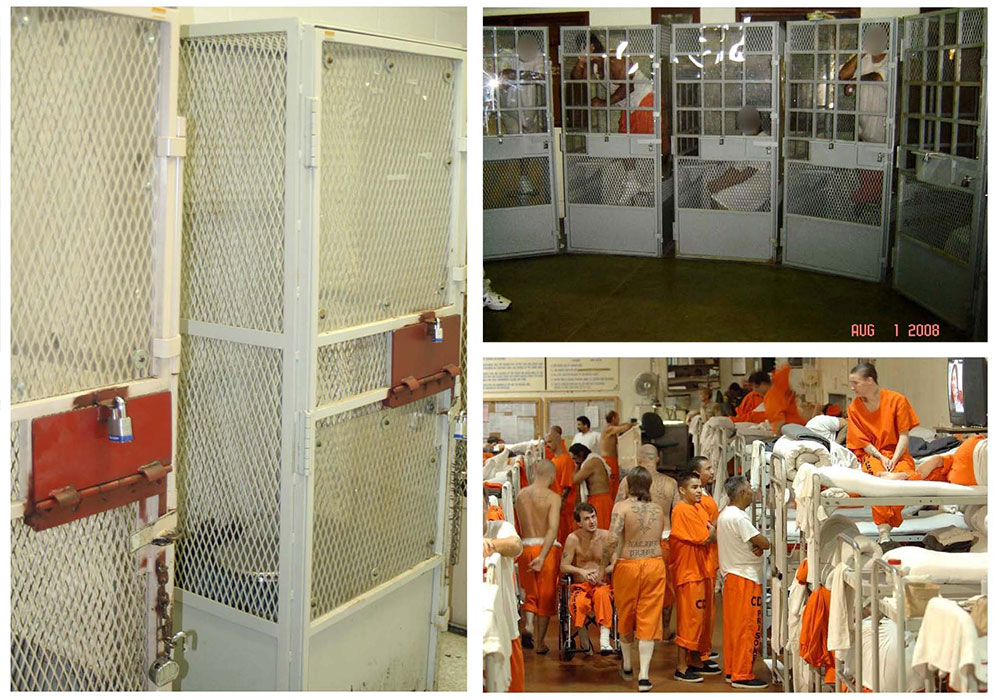
Brown v. Plata, (left) Photographer Unknown, CTC (dry cages / holding cells for people waiting for MHCB. July 29, 2008.
(right top) Five prisoners inside five holding cages, Administrative Segregation Unit (ASU), C-Yard, Building 12, Mule Creek State Prison, California. August 1st, 2008.
(right bottom) Photographer Unknown, Dorm Overcrowding. August 7, 2006.
The photographs submitted by the Prison Law Office and San Francisco law firm Rosen Bien Galvan & Grunfeld LLP were a critical part of the victory. The low-resolution digital images are nothing special; aesthetically they are the antithesis of art or photographic narrative. And yet no photojournalist or documentary photographer’s works have achieved a structural change and widespread benefit as profound as the 200 evidentiary images from Brown v. Plata and the consequent appeals.
Conclusion: How To Think about Images for Social Justice
While these works remind us that prisons and those who live in them are both distorted and obscured within American political and entertainment culture, prisons are also hidden in plain sight/site. They are there if we are prepared to see them for what they are and how they function. Ruth Wilson Gilmore contends that alongside labor, land, financing, and organizational capacity, prisons have become an integral part of our economic infrastructure:
While not always public, [infrastructure] is the form of most public wealth … prisons are a monumental aspect of the ghastly public infrastructure underlying a chain of people, ideas, places, and practices that produce premature death the way other commodity chains crank-out shoes or cotton or computers. Why don’t our heads burst into flames at the thought? Why is the prison-industrial complex so hard to see? 17
Hackneyed and clichéd photos of razor wire, anonymous silhouettes, and hands through bars serve stock photography agency sales more than they do informed debate. But, we mustn’t give up on images. We must instead look toward more elusive and unexpected types of imagery. By showcasing vernacular, surveillance, evidentiary, workshop-inspired, collaborative, and prisoner-made photographs, Prison Obscura purposefully offers new models of seeing, recording, and making visible.
Susan Sontag’s proclamation that photography is an act of violence18 has long stunted debate about photography’s value, suggesting that documentary photography has simply accelerated compassion fatigue, deadened conscience. Nonsense. How quick we are to forget that it is the camera that has done so much to globalize our political consciousness. Better than any other thinker in recent years, Susie Linfield has pushed back against the evasions of Sontag and the like. “The answers to these questions reside not in pictures but in ourselves,” says Linfield. “Photographers are responsible for the ethics of showing, but we are responsible for the ethics of seeing.… This requires transforming our relationship to photographs from one of passivity and complaint to one of creativity and collaboration.” 19
In the work of Emdur, Davis, Wilkins, Gumpert, and Strandquist, we see radical engagements with prison populations, active and collaborative models of documentation. Rucker, Begley, and the photographs of Brown v. Plata similarly negate the “anointed” named artist. Begley’s satellite views and Emdur’s snapshots are examples of narrative-rich images that have lain dormant until now.
Rarely will a prison grant a photographer access if there is a risk he or she might depict the institution in a bad light. Exposé via photography is very uncommon. Photographers do enter prisons at the invitation of the prison administration, and as such, there is ever the charge that a documentary photographer is acting as an extension of the prison authority. The works of Prison Obscura disrupt such accusations, in part because they demand that the viewer investigate on his or her own and join prisoner and photographer in further advocacy efforts.
Wilson Gilmore argues that we must build an “infrastructure of feeling” between viewer and subject, one that circumnavigates the misinformation and non-information characteristic of the prison industrial complex. What pinhole of light, what teasing opportunity do we now have through which to view and change prisons? The recent economic crisis has reinvigorated discussion on criminal justice budgets and prison populations. While the dialogue would benefit from a national moment of moral enlightenment, financial necessity will have to suffice for now. Certainly, it will take more than a few prison closures and compassionate release programs to claw back four decades of flawed policy, but we can all purposefully influence this moment by understanding the failures, and those who have lived the consequences, more fully.
Footnotes
- Doy, Gen. Picturing the Self: Changing Views of the Subject in Visual Culture. New York: I. B. Tauris & Co., 2005. Print. ↑
- Stevenson, Bryan. Interview by Pete Brook. “A Conversation With Bryan Stevenson [Part Two].” Prison Photography. 1 Nov 2012. Nov . Web. ↑
- Gawande, Atul. “Hellhole.” The New Yorker. Conde Nast, 30 Mar. 2009. Web. ↑
- Grassian, Stuart. “Psychiatric Effects of Solitary Confinement.” Journal of Law & Policy 22.325 (2006): 327-80. Washington University in St. Louis | Law School. Washington University School of Law, 2006. Web. ↑
- Greene, Judith, Kevin Pranis, and Natasha A. Frost, Ph.D. HARD HIT: The Growth in the Imprisonment of Women, 1977-2004. Rep. no. 7. Women’s Prison Association, May 2006. Web. ↑
- Talvi, Silja J. A. Women behind Bars: The Crisis of Women in the U.S. Prison System. Emeryville, CA: Seal, 2007. Print. ↑
- The Drug Policy Alliance reports that the U.S. has spent $1 trillion on the War On Drugs. Drug arrests have more than tripled in the last 25 years, totaling more than 1.63 million arrests in 2010 alone, and an estimated a total of 45m arrests have been made over the past 40 years. The number of people imprisoned for drugs charges has increased from 50,000 in 1980 to more than 500,000 today. “Forty Years of Failure.” Drug Policy Alliance. Drug Policy Alliance, n.d., December, 2013. Web. ↑
- “Changing Public Attitudes Toward the Criminal Justice System.” Open Society Foundations (OSF). Peter D. Hart Research Associates, Inc. for The Open Society Institute, Feb. 2002. Web ↑
- Brook, Pete. “PPOTR Dispatch #10: Prison Visiting Room Portraits, An Interview with Alyse Emdur.” Prison Photography. Prison Photography, 3 Jan. 2012. Web. ↑
- Alyse Emdur can be largely credited for distributing both the images and providing context for prison visiting room portraits and the backdrops. The artist David Adler similarly used correspondence with scores of prisoners to source this type of imagery. ↑
- Report of The Sentencing Project to the United Nations Human Rights Committee: Regarding Racial Disparities in the United States Criminal Justice System. Publication. The Sentencing Project: Research and Advocacy for Reform, Aug. 2013. Web. ↑
- (Talvi) ↑
- The racial breakdown of women prisoners is as follows: 95,300 Euro-American, 68,800 black women, 32,400 Latinas. (Talvi) ↑
- Of the 1.7 million children with incarcerated parents, over 40% are African-American children. That’s one in 15 black children in the U.S. black children are eight times more likely to have an incarcerated parent than a white child. Glaze, Lauren E., and Laura M. Maruschak. Parents in Prison and Their Minor Children. Rep. Washington, DC: Bureau of Justice Statistics, 2010. Print. ↑
- Mendel, Richard A. No Place for Kids: The Case for Reducing Juvenile Incarceration. Rep. The Annie E. Casey Foundation, 2011. Web. ↑
- (‘No Place for Kids’) ↑
- Gilmore, Ruth Wilson. Golden Gulag: Prisons, Surplus, Crisis, and Opposition in Globalizing California. Berkeley: University of California, 2007. Print. ↑
- Sontag, Susan. On Photography. New York: Farrar, Straus and Giroux, 1977. Print. ↑
- Linfield, Susie. The Cruel Radiance: Photography and Political Violence. Chicago: University of Chicago, 2010. 47. Print. ↑
Bibliography
- Linfield, Susie. The Cruel Radiance: Photography and Political Violence. Chicago: University of Chicago, 2010. Print.
- Talvi, Silja J. A. Women behind Bars: The Crisis of Women in the U.S. Prison System. Emeryville, CA: Seal, 2007. Print.
- Greene, Judith, Kevin Pranis, and Natasha A. Frost. Hard Hit: The Growth in the Imprisonment of Women, 1977-2004. Rep. Women’s Prison Association, 2006. Web.
- Report of The Sentencing Project to the United Nations Human Rights Committee Regarding Racial Disparities in the United States Criminal Justice System. Rep. The Sentencing Project, Aug. 2013. Web.
- Changing Public Attitudes toward the Criminal Justice System. Rep. N.p.: Peter D. Hart Research Associates, 2002. Print.
- Waldman, Ayelet, and Robin Levi, eds. Inside This Place, Not of It: Narratives from Women’s Prisons. San Francisco: McSweeney’s, 2011. Print.
- Mauer, Marc, and Meda Chesney-Lind, eds. Invisible Punishment: The Collateral Consequences of Mass Imprisonment. New York: New, 2002. Print.
- Carson, E. Ann, and Daniela Golinelli. Prisoners in 2012 – Advance Counts. Rep. Bureau of Justice Statistics, July 2013. Web.
- Watterson, Kathryn. Women in Prison: Inside the Concrete Womb. Boston: Northeastern UP, 1996. Print.
- Mendel, Richard A. No Place for Kids: The Case for Reducing Juvenile Incarceration. Rep. The Annie E. Casey Foundation, 2011. Web.
- Stevenson, Bryan. “A Conversation With Bryan Stevenson [Part Two].” Interview by Pete Brook. Prison Photography. N.p., 1 Nov. 2012. Web.
- Emdur, Alyse. Prison Landscapes. London: Four Corners, 2012. Print.
- Pattillo, Mary E., David F. Weiman, and Bruce Western. Imprisoning America: The Social Effects of Mass Incarceration. New York: Russell Sage Foundation, 2004. Print.
- Macallair, Dan. “PPOTR Dispatch #3: Interview with Dan Macallair, Executive Director of the Center on Juvenile and Criminal Justice.” Interview by Pete Brook. N.p., Oct. 2011. Web.
- Kirkham, Chris. “Prisoners of Profit.” Web log post. The Huffington Post. N.p., 22 Oct. 2013. Web.
- “Quote: Annual Costs.” Juvenile in Justice. Juvenile In Justice, 13 Oct. 2013. Web.
- Lyman, Michael D. Drugs in Society: Causes, Concepts and Control. 6th ed. Cincinnati, OH: Anderson, 2010. 367. Print.
- Beresford, John, ed. The Tallahassee Project: One Hundred Prisoners of the War on Drugs: A Project of the Committee on Unjust Sentencing. San Francisco: Last Gasp of San Francisco, 2001. Print.
- Wakefield, Sara, and Christopher Uggen. “Incarceration and Stratification.” Annual Review of Sociology 36 (2010): 387-406. Web.
- Western, Bruce, and Becky Pettit. “Incarceration & Social Inequality.” Daedalus 139.3 (2010): 8-19. Print.
- One in 100: Behind Bars in America 2008. Rep. Washington, DC: Pew Charitable Trusts, 2008. Print.
- Pettit, Becky. Invisible Men: Mass Incarceration and the Myth of Black Progress. New York: Russell Sage Foundation, 2012. Print
